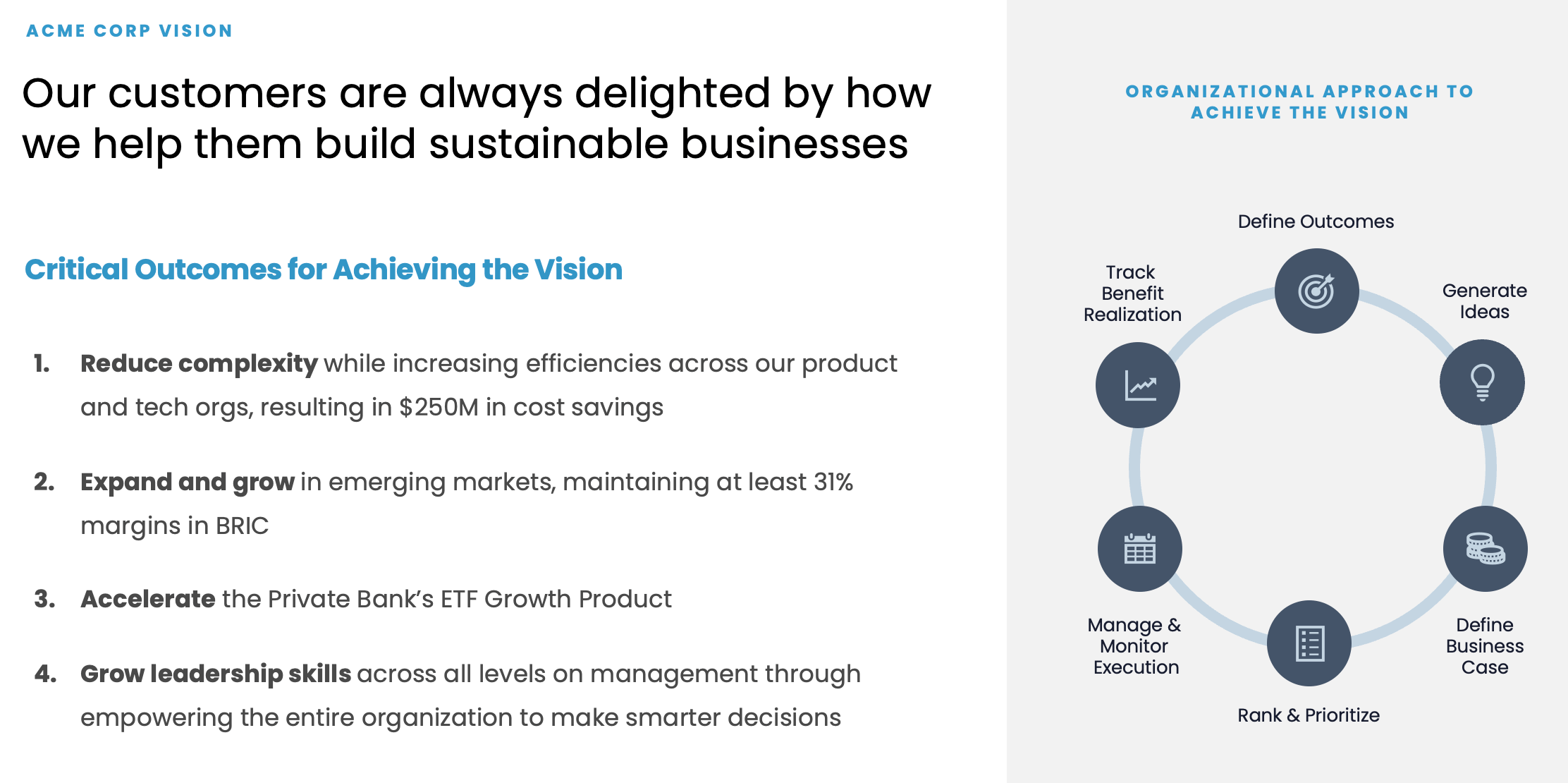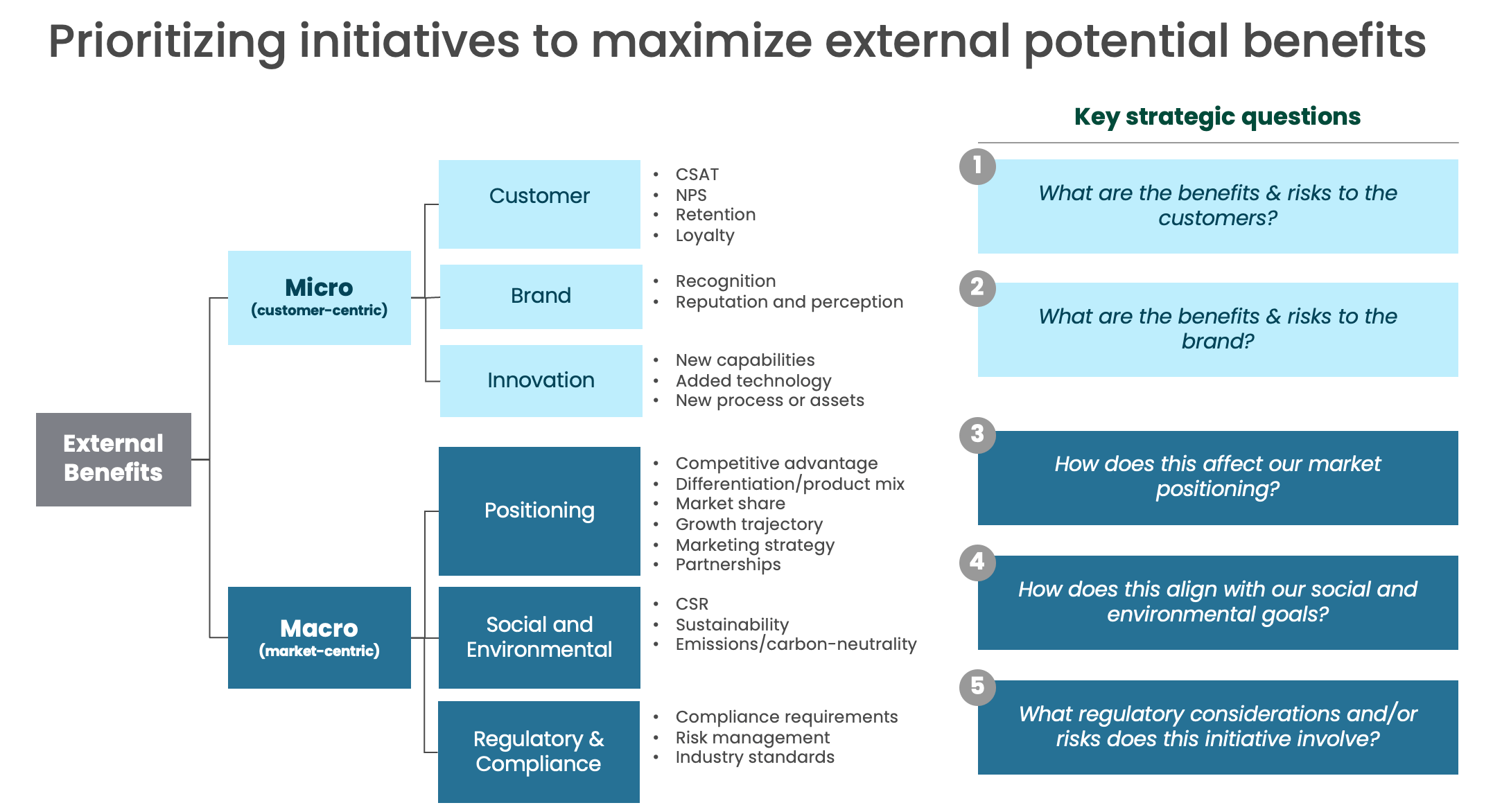In 2016, about 74% of employees were willing to support organizational change. However, Gartner reported that the statistic fell to only 38% in 2022. This is becoming a serious problem as more and more organizations operate in a mode of continuous transformation.
For any business transformation to succeed, clear goals need to be set from the start. If you want employees and other stakeholders such as suppliers or partners to embrace the change and put in sustained effort, they must understand where the organization is going and how they fit into the journey.
After seeing the transformation journeys undertaken by hundreds of organizations at Shibumi, we know that setting the right goals and milestones – goals that motivate employees to get behind the effort and expend their energy – is undeniably one of the most critical parts of any transformation journey. That’s why we’ve decided to share our best thinking on how to a create a blueprint for transformation success in this piece.
Start by Defining What Success Looks Like
You know your organization wants to make some drastic corporate performance improvements.
But how do you break this big goal down into concrete, specific goals and start to set milestones various teams/business units can get behind?
Let’s learn through an example of a fictional company called Acme Corp. For over 25 years, Acme Corp has been a leader in global technology dedicated to building a sustainable business. Acme Corp has several top-level goals and focus areas for the company. One of the focus areas is to improve financial performance, measured by metrics such as revenue growth, ROI, EBITDA, gross margins, and cost savings. Another goal is to improve operational performance, where success would be determined by innovation rate, time to market, process cycle time, and productivity rate. A third focus is to enhance leadership skills across all levels of management – so people are better positioned to achieve the first and second goal.
These focus areas are a great place to start. Based on these goals, Acme Corp could build on those focus areas and create specific, measurable objectives. To put their vision of improved financial performance into action, they could establish several more specific goals. One specific goal is to achieve $250 million in cost savings in a year by reducing complexity while increasing operational efficiencies across the organization. A second goal is to expand into emerging markets while maintaining a target margin of 31% in the BRIC (Brazil, Russia, India and China) countries.

By identifying goals and translating them into measurable objectives, Acme Corp can give itself a roadmap to start its transformation journey.
Prioritize Initiatives Based on Benefits
As Shibumi studied transformation programs, we noticed some common pitfalls. Many businesses tend to get stuck in one particular area: Company leaders often can’t agree on which specific initiatives to prioritize implementing. Other common frustrations around transformation include a lack of roadmap visibility, inefficient allocation of resources, lack of adequate coordination between teams, project delays and cost overruns.
These issues don’t just decrease the productivity. They also degrade employee morale — which ultimately reduces the potential benefits of the transformation. While each of those pitfalls is distinct, they share a common solution: they could all be solved (or at least mitigated) if the organization could consistent prioritize the right initiatives.
So, how do you correctly prioritize your initiatives? The key is to ground your decisions in terms of benefits. While this is an art more than a science, we typically see organizations evaluating their initiatives through four benefit categories:
- Alignment. Is what we are doing clearly moving the needle on company-wide priorities? Each organization must prioritize certain goals over others within a given timeframe.
- Financial value. Can we clearly measure the financial benefits (e.g., revenue, costs) to determine ROI? Profitability is the lifeblood of any company. Regardless of duration, each idea and initiative must be meticulously assessed for its potential to contribute to the company’s profitability, safeguarding its financial health and sustainability.
- External benefits. What is the impact on stakeholders outside the company, like customers, investors, etc.? Initiatives aimed at enhancing the company’s reputation and market position are crucial. They are designed to attract and retain customers, build brand loyalty, and foster trust.
- Internal benefits. Will this strengthen our relationship with employees and enhance our culture? Initiatives that aim to develop talent, upskill employees, and improve culture will help an organization attract and retain top talent and foster loyalty — which in turn lowers hiring costs and positions the organization to build better products and deliver amazing customer experiences.
By assessing benefits through these four categories, organizations will get a clearer sense of what matters most to them. These categories should be weighted according to your business priorities and needs.
How to Forecast and Quantify the Financial Value of Initiatives
Determining the financial value of initiatives may be simple or quite involved. If you’re unsure of how to get a solid forecast of financial value, start with the techniques below:
- Gather information: Gather information through market research, competitive analysis, customer feedback and internal cost/resource data sources.
- Do a cost estimation: Estimate both the initial and ongoing costs associated with the initiative. This includes direct costs (e.g. technology, labor, materials) and indirect costs (e.g., training, overhead, maintenance).
- Make revenue & cost savings projections: Consider different revenue streams, pricing models and sales forecasts and the potential cost reductions through streamlined processes, resource optimization, or other efficiency measures.
- Payback period: Determine the time it takes to recoup the initial investments through the net cash flows or hard-dollar savings generated by the initiatives. .Run the calculation to determine the anticipated net benefits over the requite time horizon.
- Risk assessment: Identify potential risks and uncertainties that could impact the financial outcomes of the initiatives (resources, customer adoption, etc.) Assess the likelihood and potential impact of these risks
- Conduct a sensitivity analysis: Evaluate how changes in key variables or assumptions impact financial outcomes, helping to identify the initiatives’ sensitivity to different scenarios (e.g. a change in demand).
Define Specific Success Criteria For Key Initiatives
Once you’ve identified your objectives and key initiatives, it’s time to define specific success criteria for your key initiatives.
The specific, relevant indicators should vary by the type of initiative you’re implementing and the key stakeholders/topics you want to influence. For example, good success measures for initiatives that aim to improve customer experience with your software may include Customer Satisfaction, NPS, Retention and loyalty, while a sustainability initiative’s success should be judged based on measures that like CO2 emission reduction or waste reduction.
A framework on prioritizing initiatives to maximize external potential benefits.

Of course, not all strategic intiatives need to benefit external stakeholders. Initiatives focused on upskilling employees, improving employee satisfaction and retention can be critical to the success of certain transformations (e.g., Digital Transformation, RPA/Intelligent Automation program).
Leading indicators for initiatives influencing employee satisfaction and culture include:
1.Employee Engagement Surveys: Regular surveys can measure employee engagement and satisfaction. Positive trends indicate a happier workforce.
2.Feedback and Idea Generation: Employee-generated ideas and feedback to management are signs of involvement and satisfaction.
3.Participation in Training & Development Programs: A higher rate of employee participation rate in training and development programs suggests that employees are eager to acquire new skills and grow within the organization.
4.Peer-to-Peer Recognition: Frequently happening peer-to-peer recognition and appreciation within the organization is a signal of a positive, collaborative culture.
5.Employee Cycle Time: Measures the time elapsed from the initiation of an activity, such as submitting a request or starting a project, to its successful completion or resolution. An enhancement can mean increased autonomy, better collaboration, and time freed for driving other elements of the strategy.
Lagging indicators for initiatives influencing employee satisfaction and culture include:
1.Employee Retention Rate: Measures the percentage of employees who stay with the organization over a specific period, typically annually. A higher retention rate indicates employees are satisfied and committed to the company.
2.Employee Satisfaction Surveys: A consistent increase in employee satisfaction scores over a timeframe suggests efficacy in initiatives.
3.Productivity Metrics: Improvements in individual or team productivity, sales performance, or project completion rates can be a result of a more satisfied and engaged workforce.
4.Growth in Internal Promotions: Measuring the percentage of promotions filled internally versus externally. A higher percentage of internal promotions suggests that employees are advancing within the organization, which is often tied to job satisfaction.
Exit Interviews and Turnover Reasons: Identifying a decrease in turnover due to dissatisfaction or a shift in reasons can be indicative of improved culture and happiness
Once you have the right set of measures for gauging the success of the initiative, the next step is to baseline the current starting point of the metrics that the initiatives will impact. A solid baseline will help you set realistic growth targets for your progress.
After that, you’ll forecast the uplift your initiative will bring to the identified key metrics.
Once you’ve done this, it is time to launch your initiative with leadership support and required communications.
Keep in mind that this process isn’t always linear; you may need to move back and forth between steps occasionally, especially if this is your organization’s first major transformation.
Further, once initiatives have launched and you start to measure their progress, you may find that some initiatives are not on a trajectory to meet your targets. If that’s the case, you may shift resources away from the under-performing initiative to more promising ones.
Making Improvements to Core Capabilities to Accelerate Transformation Success
While prioritization is a make-or-break factor in transformation success, a few other factors are just as influential to the final outcome, including leaders’ ability to see what’s on the roadmap, how resources get allocated to various initiatives, how risks are managed and the timeliness/quality of communication.
If you want to increase the odds of success, you need to understand your capability gaps and address them. Based on Shibumi’s experience with clients across a variety of industries, here are the make-or-break factors that impact transformation program success:
| Success/Value Driver | Pitfall and why it’s problematic | Ideal state and how it contributes to success |
| Alignment, Focus | Misaligned strategic goals result in execution gaps | Aligning strategic goals with execution leads to better business outcomes |
| Growth, Innovation | Insufficient idea tracking and management is hindering innovation potential and benefit pipeline coverage. | Better management of new ideas and faster evaluation of their potential impact on the business provides greater benefit coverage |
| Speed, Confidence | An inability to evaluate and compare business cases for new initiatives | Ability to quickly and effectively evaluate business cases for new initiatives, resulting in better resource allocation and higher ROI |
| Risk Mitigation | Lack of consistent governance practices across the organization for planning and executing initiatives | Enhanced risk management and improved compliance through consistent governance practices for initiatives |
| Efficiency, Focus | Lack of roadmap visibility is impeding resource allocation and collaboration | The roadmap is transparent and visible to all stakeholders — enabling effective resource allocation and collaboration. |
| Agility | Poor allocation of resources; difficulty in tracking resource utilization | Resource allocation decisions are driven by organizational values and supported by data — resulting in higher productivity. |
| Risk Mitigation, Cost Savings | Poor management of risks, issues and dependencies, leading to delays and cost overruns | Single source of truth for risks, issues and dependencies, which mitigate delays and cost overruns |
| Speed, Growth | An inability to measure and track the benefits and ROI, leading | Clear measurement and tracking of benefits and ROI, leading to better decision-making and greater accountability |
| Speed, efficiency | Reactive decision-making driven by lackluster reporting capabilities and lack of timely data | Stakeholder can access the reports they need in real-time, leading to time saved in reporting process and more reliable decision-making |
| Growth, risk mitigation | Scenario planning and evaluation isn’t done or is done infrequently; leaders do not adequately anticipate risks that result from changes in the business environment. | Value-driven scenario planning is done in a timely manner, which lets leaders respond to changes in the business environment quickly and better manage risks. |
To transform your business successfully, you’ll need to include multiple stakeholders in the planning process. Any transformation blueprint development should include stakeholders from finance, marketing, IT and business operations. You’ll also want to involve any department leaders who will be executing specific initiatives and stakeholders who will support the technology and infrastructure needed for these initiatives. Together, stakeholders can offer insight from their unique areas of the business.
Shibumi’s Role in Transformation Success
You also don’t have to implement the process alone. Shibumi’s software is designed to help you manage all the steps of a transformation program, from planning to execution management all the way to benefits reporting. Additionally, we’re able to provide you with the methodology expertise and good practices that can help drive lasting change in your organization. To see how Shibumi can accelerate your transformation, request a demo today.
The information in this blog was based on the Shibumi webinar “Set Goals and Build a Success Blueprint for Your Transformation Program.” For more detailed insights into how to create a blueprint for transformation success, watch the webinar here.

